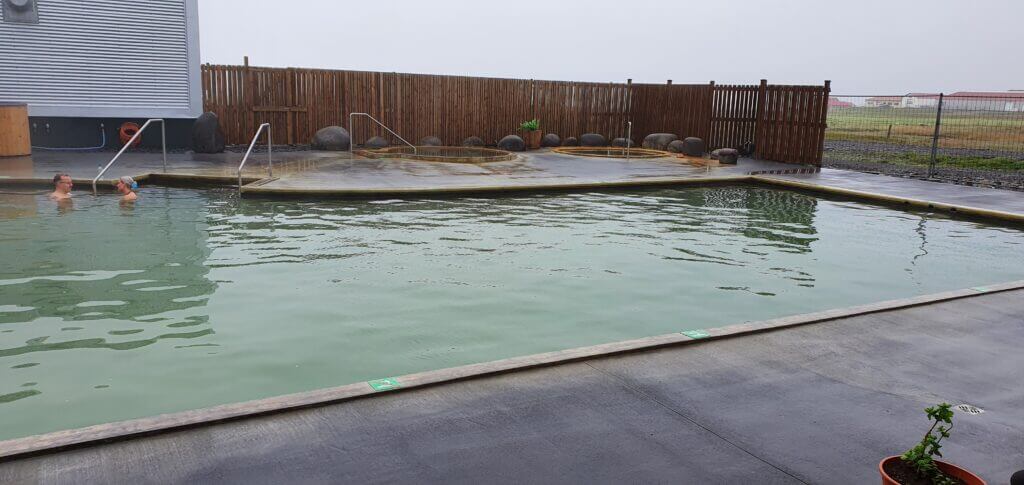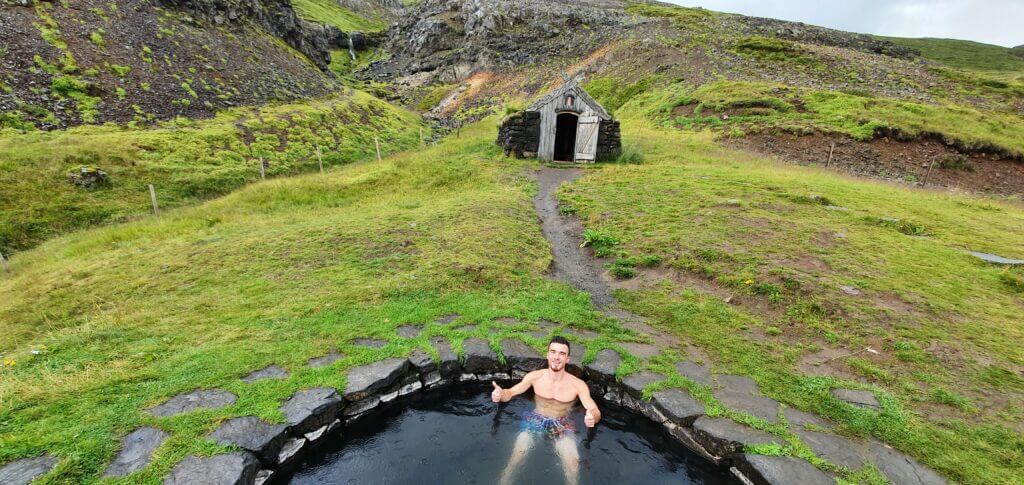On day 10 of our journey, we had planned to make a few stops around Snaefellsness peninsula and then head towards Westfjords from the northern part, starting in Drangsnes.

The westermost road on Snaefellsnes peninsula – Útnesvegur in Snæfellsjökull national park
We adjusted our plans according to the weather. The next day was supposed to be without rain in the northern part of Westfjords and the day after that was again supposed to be clear in the southern part of Westfjords.
Contents
Saxhóll crater
8:30-8:50
Distance from car park: 0 minutes Time spent at: 10-20 minutes Worth visiting even with bad weather: no, probably Physical condition needed: little Interesting index: 3 – nice (1-amazing, 2-great, 3-nice)

Saxhóll crater in the distance
Our first stop was Saxhóll crater, mostly because we had it right on our way towards the south part of Snæfellsnes. It’s a nice little crater, which you may ascent to the top thanks to the artificially built staircase. Compared to other sites in Iceland it’s not that interesting, but it’s still a nice and easy place to see.

Saxhóll crater – staircase
Londrangar cliffs
9:10-9:30
Distance from car park: 5 minutes Time spent at: 5-20 minutes Worth visiting even with bad weather: yes, probably Physical condition needed: little Interesting index: 2 – great (1-amazing, 2-great, 3-nice)

This is how Londrangar cliffs are supposed to look like on a beautiful day. Source: https://www.reddit.com/r/EarthPorn/comments/afac1w/londrangar_sn%C3%A6fellsnes_peninsula_iceland/
At one of the southernmost points of Snafellsness lie Londrangar cliffs. There’s a car park pretty near the actual viewpoint for the cliffs. So, it’s a quick stop which you should take when driving around the area.
Weather on day 10 of our journey was very unstable, with some parts of Snæfellsnes being cloudy, some clear and some really foggy. Londrangar cliffs belonged to the last category, that’s why we even didn’t take any pictures. We were able to observe only their silhouette, but I admit, they seemed to be really picturesque when the weather is nice.
Stóri Kambur horse riding
10:00-11:00
Distance from car park: 5 minutes Time spent at: 1 to 1,5 hour Worth visiting even with bad weather: yes, probably Physical condition needed: little to medium Interesting index: 1 – amazing (1-amazing, 2-great, 3-nice)
Icelandic horses – what is this all about?
Icelandic horses are smaller compared to “regular horses”, so it’s a bit easier to ride them. Icelandic horses, or in other words, Icelandic ponies are quite different from all other horse species around the world. More specifically, it is a unique breed of horse, exclusive solely to Iceland.

Icelandic ponies in Landmannalaugar
There’s even a law which states that it’s not allowed to breed any other type of horses in here. And once the Icelandic horse leaves the island, he’s even not allowed to come back. So – it’s some kind of a secluded, exclusive VIP horse club, here in Iceland.
What horse-riding tour we chose and why?
The only “paid tour” we opted for in Iceland was a horse-riding tour. Why? Well, my girlfriend is really into horse-riding and she longed for trying it also here in Iceland.
I tried to combine our horse-riding tour with seeing some nice landscapes as well. That’s why I chose the Stóri Kambur horse-riding tour. They offered a tour which leads along the Snæfellsnes beach, which sounded really nice. And, for a reasonable price of 50eur/person for the 1-hour lasting tour.

Stóri Kambur horse riding on the Snaefellsnes beach
I booked the tour just the day before, in the afternoon, by phone, found on their website. However, that was during Covid-19 times. Maybe during normal times, you would need to book more in advance.
Our horse-riding experience
We can now assess our horse-riding experience from the point of view of a non-rider (me) and a slightly experienced rider (my girlfriend). The entire tour was really chill, and the better-suited name for it would be “horse-walking”. There were just 2 of us (me and my girlfriend) and two German students rode with us as guides employed by Stóri Kambur.
For me as a non-rider, this walking pace was just right, I definitely didn’t feel like going faster. For my girlfriend, it was probably too slow, but she was fine with that. Bear in mind, that if you go as one group, you can’t go at a different pace, otherwise, the horses could get confused. So then, it’s better to go either in separated groups (if you want to go at a different pace) or get used to the same pace for the entire group.

Horse riding on a Snaefellsnes beach
The scenery around and the atmosphere was stunning, however. The guides rode our horses via lake (yes, the horses were walking through lake) and finally we reached the beach right next to the sea waves. We rode on the beach for a while, made some pictures and then turned back. We were the only living creatures in that area. Very nice experience. Although we got wet (from the lake), cold (from the wind), dirty (from the mud) and stinky (from the horses), it was definitely worth it.
Lýsuhólslaug hot spring
12:00-13:15
Distance from car park: 0 minutes Time spent at: 0,5 to 2 hours Worth visiting even with bad weather: yes Physical condition needed: little Interesting index: 2 – great (1-amazing, 2-great, 3-nice)

Lýsuhólslaug hot spring
After finishing our horse-riding tour, we felt really cold. If only there was some hot spring nearby. Oh wait, you are in Iceland, let’s Google the nearest hot spring! And yes, luckily, the nearest hot spring was supposed to be a 15-minute drive by car away.
How to get to Lysuholslaug and what to expect
Don’t get fooled by Google that you have to walk to this hot spring. You don’t have to. There’s a road leading right next to the hot spring area. It’s just not marked on the Google Maps (see below).

Lýsuhólslaug hot spring as indicated on Google Maps. The road to it does exist, though.
This hot spring is the man-made one, man-maintained and paid (6-7Eur/person). This time we didn’t mind paying a few Euros for it and even sharing it with other visitors, because we really felt like going for the hot spring. It goes without saying that you may use entire infrastructure around, i.e. changing rooms, toilets and showers.
Lýsuhólslaug bathing experience
There are 2 small hot tubes and 1 bigger pool. All of them are the so-called “sea-weed baths”. That means, they look to be dirty, because of the sea-weeds everywhere. The ground and walls of the pool are also slippery, because of sea-weeds.
The big pool has the water of temperature around 32°C (according to my professional assessment, i.e. read “just guessing”). Water in the small hot tubes is much hotter, around 36-38°C in the first of them and around 39-41°C in the hottest one. It’s definitely not recommended to stay in the hottest one for too long.

Road 55 – Heydalsvegur
Bathing in Lysuholslaug is definitely a very pleasant activity when the weather sucks. We really enjoyed it, despite the place not being anywhere near as picturesque as Hrunalaug or some other “wilder” hot springs. So, it depends on your preference, weather (and who knows what else), whether it’s worth making a detour for you. For us it definitely was.
Other than us, there was just one other couple using the pools at the time of our visit. We guess the main reason was, once again, Covid pandemic, rather than the place being unpopular.
Guðrúnarlaug hot spring
16:00-16:40
Distance from car park: 5 minutes Time spent at: 30-60 minutes Worth visiting even with bad weather: yes Physical condition needed: little Interesting index: 1 – amazing (1-amazing, 2-great, 3-nice)

The neighbourhood of the Guðrúnarlaug hot spring
As we had planned, next we headed towards Westfjords. On a halfway there, we made a detour to another cool hot spring – Gudrunarlaug.
How to get to Gudrunarlaug and what to expect
Guðrúnarlaug is definitely a bit more touristy compared to, for example, Lýsuhólslaug. The reason for that is its proximity to ring road and to Westfjords, i.e., it’s quite easily accessible. The same is true when it comes to access to the actual hot tube – it’s a 2-minute walk from the car park, which sits right next to it. Google Maps are also quite precise about the location of Gudrunarlaug, so feel free to orientate according to them.
Guðrúnarlaug is located next to the small rural campsite (we didn’t see anyone camping at the time of our visit, during Covid-19 times) and something which looked like a school. There’s an authentic wooden shelter (similar to the one next to Hrunalaug) serving as a changing room, right next to the pool. Hot spring is free to use, I don’t remember a donation box next to it, but there may have been one.
Guðrúnarlaug bathing experience
When we arrived at the parking lot, we saw just one couple bathing in the hot spring. We were already spoiled by travelling during Covid pandemic, in the sense that we had been alone at every other place we had visited. So, we decided to wait a bit once the couple finishes its bathing, which took about 5 minutes.

Shelter for changing clothes and Gudrunarlaug hot spring
Yep, once again, we were alone in Icelandic hot spring, in August at 4 pm. The rain had already been pouring when we got out of our car. We really enjoyed Gudrunarlaug bathing, even despite (or thanks to?) rain getting heavier. The place with its surroundings is pretty cool and the water is pleasantly hot (some 36-38°C). Definitely worth visiting. It was one of the best hot springs we’ve bathed in.
Drangsnes (closed) hot springs
18:15
Next, we aimed for Drangsnes. I had already realized a few days ago, thanks to a comment on Google maps, that they had closed Drangsnes hot tubes starting 1st of August. I.e. 10 days before our planned visit. Due to Covid. That was a pity because we were looking forward to trying them. Nevertheless, we already had 2 hot spring stops on that day, so we didn’t regret much not having the third one.
We made a short stop in front of the pools, just to confirm that they are closed. Next, we headed towards Drangsnes campsite, because I had planned a road trip to Krossneslaug for the following day.
Drangsnes camping
18:30-
Drangsnes campsite was the closest camping to Krossneslaug hot spring pool. It sits virtually on the edge of the fjord. Everything around is really picturesque. It takes a 3-minute walk from the campsite to reach the actual fjord and you have a view over fjord directly from the camping area. This was one of the most beautiful campsites we’ve camped in during our journey. Mostly, due to its short distance to the fjord.

Drangsnes campsite next to the beautiful fjord
The camping facilities were OK as well, with 2 kitchen areas and showers. Weather in here seemed to be milder than anywhere else because the fjord seemed to soften the wind and rain.
Skipped places
- Rauðfeldsgjá Gorge
We decided to skip Rauðfeldsgjá Gorge in Snaefellsness, although we had it on our list of places to see. Weather was very foggy and unstable at the time of us going nearby and we didn’t find the place so attractive to devote it a longer time slot (which it required because it’s a longer hike). On top of that, in our home country, we’ve already explored many gorges, so we don’t get so excited about them unless they are special somehow.




